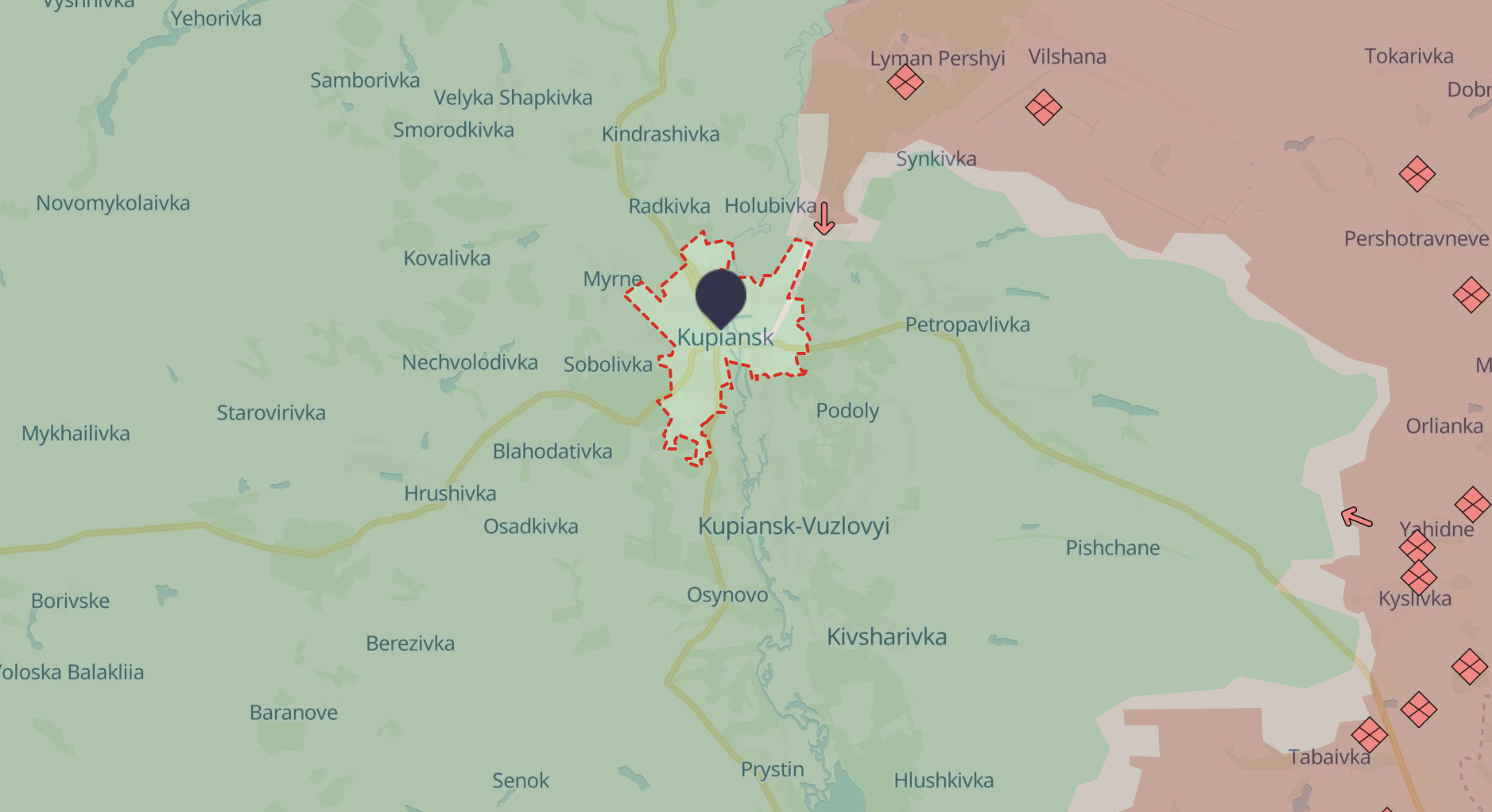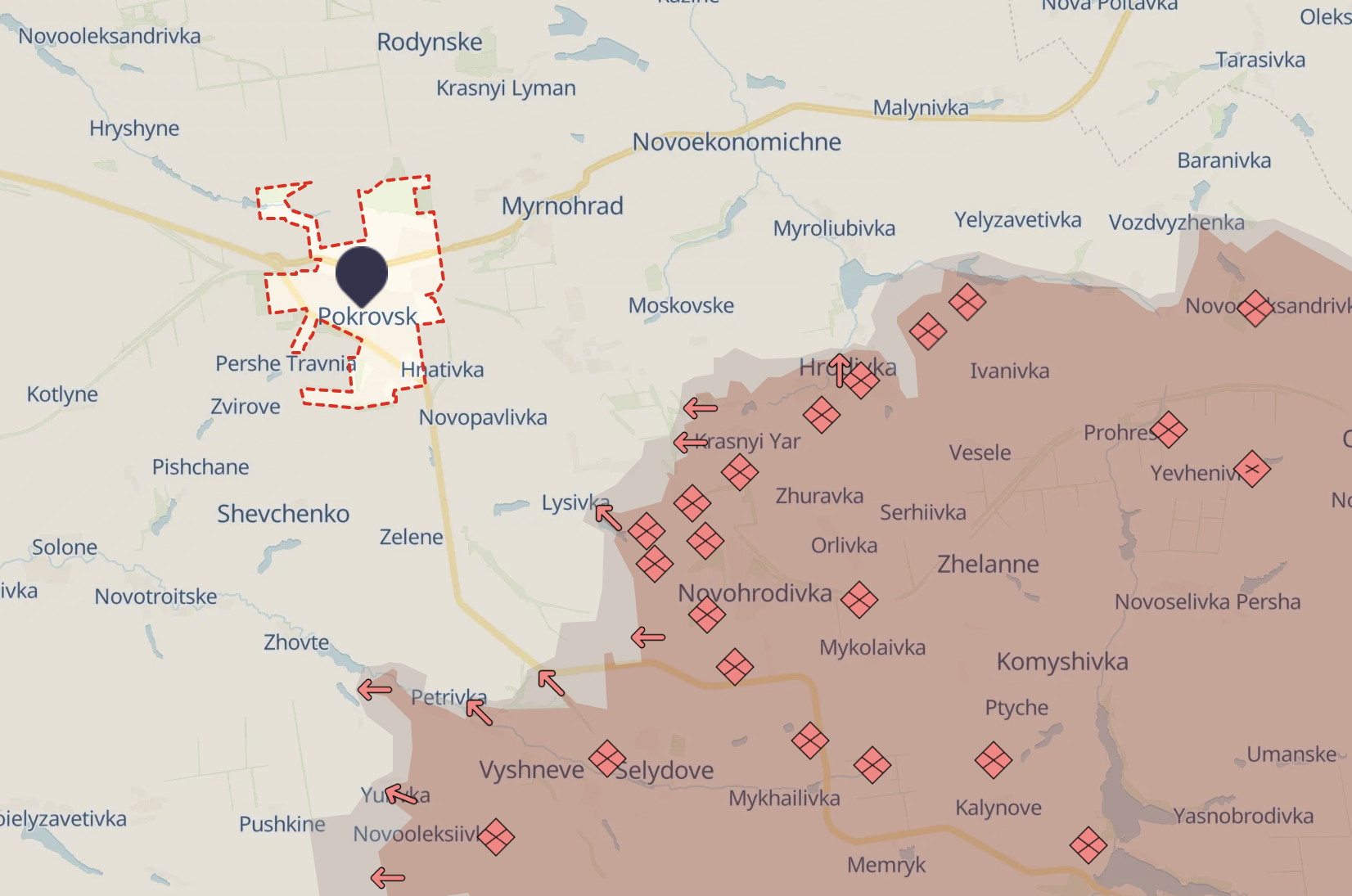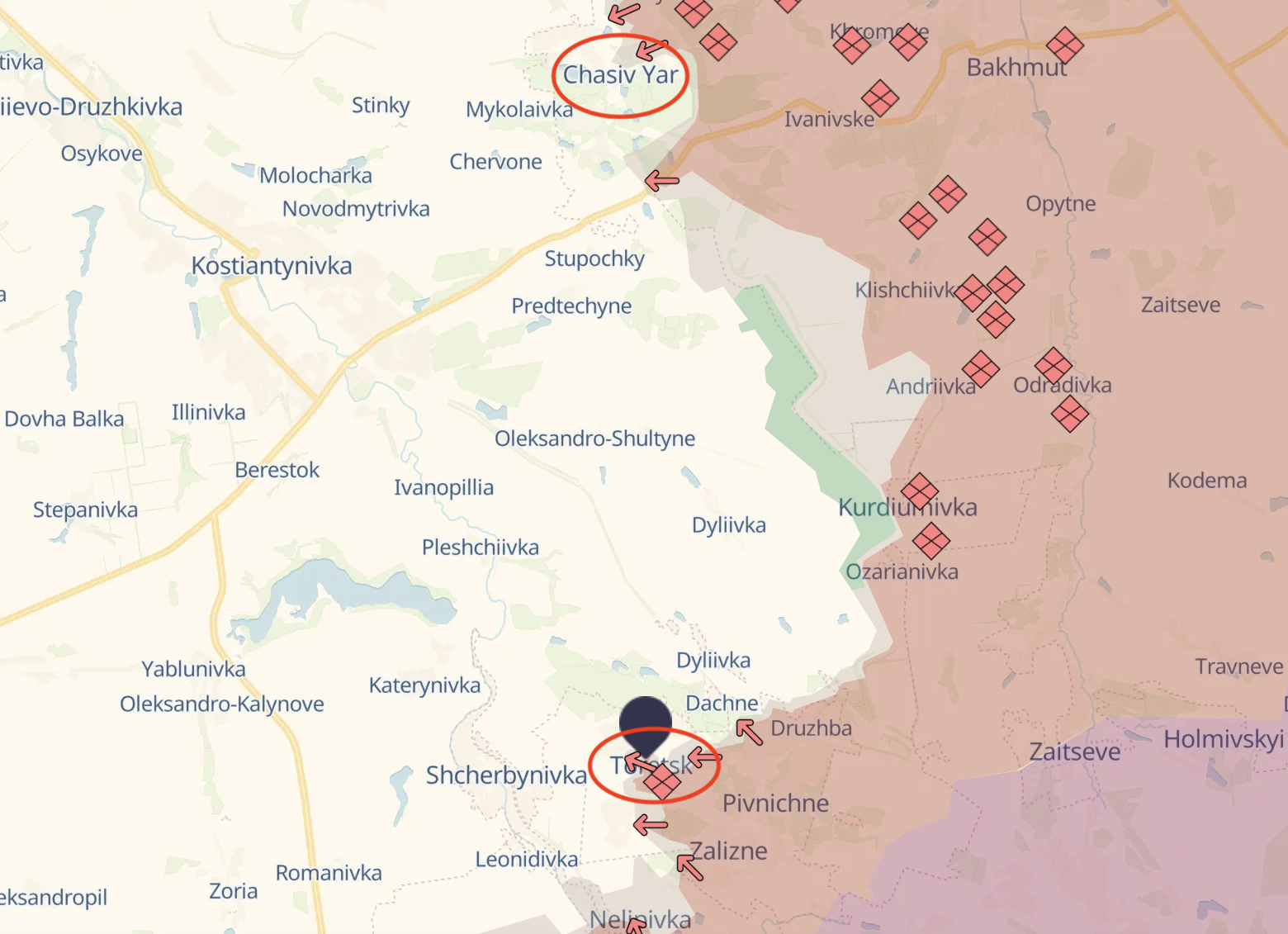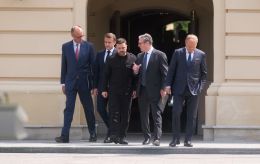No respite for Ukraine: How Russia's winter offensive could play out and what’s next for Kursk front
 Ukrainian troops repel enemy assaults with the help of drones in many areas (photo by Getty Images)
Ukrainian troops repel enemy assaults with the help of drones in many areas (photo by Getty Images)
Russian forces continue their creeping offensive in Donbas and are approaching Kupiansk. Additionally, they are preparing to push Ukrainian forces out of the Kursk region. RBC-Ukraine prepares an overview of the hottest frontlines and potential developments over the winter below.
Contents
- Kupiansk repels assault attempt
- Enemy seeks to encircle Kurakhove
- Battle for Pokrovsk delayed
- Focus may shift to Toretsk and Chasiv Yar
- Russia prepares an offensive in the Kursk region
Kupiansk repels assault attempt
After months of heavy fighting, Russian forces reached the Oskil River south of Kupiansk in late October. Following the capture of the villages of Kruhliakivka and Kolesnykivka, their advance slowed. This foothold on the Oskil’s left bank is intended for a southward push toward the northern Donetsk region, where their immediate target would be Lyman. However, the enemy must control the eastern part of Kupiansk to achieve this, as the main supply road runs through the city from Svatove.
A rapid entry into Kupiansk is only feasible through a northern strike, which Russian forces attempted. Last week, on November 13, two convoys moved from the Lyman Pershyi area. Footage online showed one transporter reaching Nekrasova Street. After it was hit, around 15 enemy soldiers scattered into nearby buildings.
The next day, Ukraine’s General Staff denied reports of Russian presence in Kupiansk. According to DeepState analysts, part of the Russian landing force was neutralized using drones. By Friday, videos emerged showing Ukrainian forces clearing the eastern district and taking prisoners.

Russia previously attempted to breach Kupiansk from the north, but Ukraine’s Defense Forces prevented them from consolidating their position (photo: deepstatemap.live).
It remains unclear how frequently the enemy will try this tactic again or if they can establish a foothold, says Oleksandr Kovalenko, a military-political expert and member of the Information Resistance group. He noted that the ability of the Russians to advance nearly 4 km along a single road from Lyman Pershyi to the Zaoskillya district is an alarming signal.
“I don’t understand how this advance was allowed. If such incidents recur, the Russians might soon secure positions on Kupiansk’s outskirts. If Ukrainian control is reinforced, they won’t succeed before the year’s end. Everything depends on the lessons learned,” Kovalenko said.
Military expert Vladyslav Seleznov emphasized that the enemy is determined to capture a critical railway hub in the eastern Kharkiv region. Gaining control would enable a southward advance along the Oskil River and allow Russia to establish a strike base against Sloviansk and Kramatorsk.
Kovalenko explained that southward from the river breach, the invaders are likely to continue moving toward Kupiansk and Borova. Notably, east of Borova, they have expanded control near the villages of Vyshneve and Pershotravneve, which provide a direct route.
“Although the front line is nearly 15 km away, the situation could repeat if the precedent at Zolota Nyva-Shakhtarske (Donetsk region, Vuhledar direction, a 6.5 km breakthrough by mechanized columns) is not addressed. I believe our troops understand this well, but isolated mistakes can still impact specific frontlines,” he added.
Enemy seeks to encircle Kurakhove
In Donbas, Russian forces have launched assaults on Kurakhove, a crucial logistical hub for Ukrainian forces. They managed to penetrate residential areas from the east, reaching the southern outskirts near the village of Dalnie, but were stopped by a counterattack from the Ukrainian Armed Forces (UAF).
“The eastern outskirts — Shakhtarska Street, Stepova Street, and the alleys between them — are under the control of Russian occupiers. The eastern part is facing constant pressure as they attempt to break into the city center. However, apart from our resistance, a ravine is hindering them — a natural obstacle similar to the canal that once stalled their advances in Chasiv Yar,” says Oleksandr Kovalenko.
Reports indicate ongoing mechanized assaults and attempts to deploy infantry. Following one of these assaults, the enemy temporarily occupied School No. 3 but was successfully pushed out.

Russian forces are attacking Kurakhove’s garrison head-on from the east while pressing from both the northern and southern flanks (photo: deepstatemap.live).
Meanwhile, the flanks are narrowing. To the north, the "gray zone" is encroaching on the village of Berestky on the shore of a local reservoir, which appears to be at least partially under enemy control. Additionally, to the south of Kurakhove, the occupiers have advanced toward the settlement of Dalnie. On the left flank, another dangerous breakthrough threatens the city from Vuhledar to the north. Along the Yasna Poliana–Maksymivka line, the enemy is also attempting to advance toward the N15 highway connecting Zaporizhzhia and Donetsk.
Judging by the direction of their strikes, the Russians aim to create the threat of encircling Defense Forces units holding the line between the Kurakhove and Vuhledar sectors.
Between the northern and southern approaches to the city lies the Kurakhove Reservoir on the Vovcha River. On November 11, the Ternivska Dam was blown up. According to official reports, this was the result of Russian shelling. Ukrainian Armed Forces soldier Serhiy Volkov told RBC-Ukraine that the main road to Kurakhove passed over this dam a month ago.
Military expert Vladyslav Seleznov believes that the Ukrainian army may soon have to engage in rearguard actions to secure the retreat of its main forces from Kurakhove.
“There are virtually no options for holding the Kurakhove garrison. If we weigh the importance of saving lives versus holding territory, saving lives should be the priority. The longer we wait, the more complicated logistics become,” he said.
Seleznov also predicts that the situation around Kurakhove could soon be shrouded in a "fog of war," as with Vuhledar and Selydove. “Even deploying significant reinforcements to this area is unlikely to change the situation,” he added.
Battle for Pokrovsk postponed
According to a report by the Institute for the Study of War (ISW), the defense of Pokrovsk has forced the Russians to change their military campaign plans in eastern Ukraine. This comes after their frontal assault failed. The offensive began in the fall of 2023 when Ukraine was constrained by the suspension of US aid.
For nearly a month, the enemy has remained about 7-8 kilometers away from Pokrovsk, focusing on advancing from the south. During this time, they managed to capture Selydove and approach a similar distance from the direction of Vyshneve.

The battle for Pokrovsk is now likely delayed until January (photo: deepstatemap.live).
Many experts previously believed that the battle for Pokrovsk would become the decisive battle of 2024. However, it seems the Defense Forces have at least managed to postpone it — for how long remains uncertain. According to Oleksandr Kovalenko, much will depend on the Kurakhove salient. The Russians will not begin their assault until they have secured their southern flank by capturing Kurakhove and all the “tails” along the Sukhi Yaly River.
“If the defense of Kurakhove continues at least until early December, it’s possible the assault on Pokrovsk may not begin until the first quarter of next year,” the expert said.
For now, the enemy is forced to take an operational pause. However, it remains unclear what resources the enemy army has. Vladyslav Seleznov notes that predictions, including those from military command, that the Russians would exhaust their offensive potential by October have not come true.
“It’s unlikely the enemy will completely refrain from attacking the Pokrovsk and Myrnohrad agglomeration this winter. However, we might see a shift in focus,” he said.
Focus may shift to Toretsk and Chasiv Yar
The enemy is constantly probing for weak spots in Ukraine’s defenses. When they find one, they redeploy forces from other areas. If the Russians detect the potential for operational-tactical or even tactical success in a specific direction, they begin concentrating their main efforts there. According to Seleznov, such a threat could arise for the defenders of Toretsk and Chasiv Yar.
In Toretsk, the enemy took a tactical pause for several weeks but has now resumed activity. Their approach remains the same: "meat-grinder" assaults with small groups. Armored vehicles are not used in urban combat, but Toretsk is under heavy artillery fire, according to Anastasia Bobovnikova, spokesperson for the Luhansk Operational Tactical Group (OTG).

The occupiers may "pivot" to Toretsk and Chasiv Yar to advance on Kostyantynivka (photo: deepstatemap.live).
The situation in Chasiv Yar is somewhat calmer for now. Reports indicate that Russian forces are regrouping; small groups are crossing the canal and attempting to fortify positions on the opposite bank.
“They are hiding in holes and basements, waiting until they gather strength for an assault. Unfortunately, we know the enemy has amassed a lot of personnel, so we expect active fighting near Chasiv Yar to resume soon,” she added.
On DeepState maps, the "red zone" has crossed the canal into the Zhovtnevyi neighborhood, while the "gray zone" has reached the central and northern districts.
“Recently, the Russians have expanded their control zone. This is a dangerous development because they have almost reached the city center. They are near the Zhovtnevyi Pond and, from the north, have advanced into the industrial zone. The situation there is genuinely tense,” said Kovalenko.
The occupiers aim to reach Kostyantynivka through Chasiv Yar and Toretsk. Meanwhile, fighting is unfolding without surprises in the Toretsk defense area. Recently, the enemy has expanded its control near Zabalka to the south of Toretsk. Within the city, battles have centered around multi-story buildings and industrial zones at Tsentralna and Mayakovskoho streets.
“It’s too early to say they can break through Toretsk and create a serious threat to Kostyantynivka. I believe they won’t succeed by the end of the year,” he added.
Russia prepares an offensive in the Kursk region
There has been no good news from the Kursk region for a while. Here, the Ukrainian bridgehead continues to shrink, but the enemy has been unable to dislodge the Ukrainian Armed Forces from the forested area between Korenevo and Sudzha. West of Sudzha, Ukrainian army defenses are gradually being pushed back as the enemy tries to establish positions in Novoivanivka and attacks Malaya Loknya.
Russian units have also partially occupied the village of Daryne. Losing it could prove costly, as it is located on the eastern bank of the Snagost River (the closest to Sudzha), from where the Ukrainian army is repelling attacks.
The bridgehead is also under attack from the east. In early November, a Russian convoy unsuccessfully attempted to enter Plekhovo. Later, they bypassed it from the north, crossed the Psel River, and engaged in battles on the outskirts. Overall, the first phase of the "counteroffensive" has ended. As the frontline shortens, the resistance of the Ukrainian Defense Forces only grows stronger.

The second phase of the Russian offensive in the Kursk region is expected soon (photo: deepstatemap.live).
The second phase is anticipated shortly. Previously, RBC-Ukraine sources reported that Putin had ordered his army to regain control of the Kursk region by February. According to Ukrainian assessments, 12,000 North Korean soldiers have been deployed there, and the total grouping may exceed 50,000 troops.
Recently, it was officially confirmed that Western partners have authorized Ukraine to strike Russian territory with long-range ATACMS and Storm Shadow/SCALP missiles. Foreign media reported that Moscow’s readiness to use North Korean forces was the trigger for lifting the restrictions after months of Ukrainian requests. This move is expected to signal Pyongyang to refrain from sending additional troops. Potential targets for these long-range missiles include logistical hubs, supply lines, ammunition depots, and troop concentrations.
Yesterday, ATACMS missiles likely struck an arsenal in the Bryansk region to disrupt Russia’s offensive plans, according to Seleznov.
“Of course, to fully deprive the enemy of the ability to supply its grouping in the Kursk region, several strategic depots in that area and neighboring regions must also be destroyed. These facilities supply the Kursk grouping,” he explained.
Kovalenko believes that the authorization to use Western missiles will unlikely deter Russian intentions. How long the Defense Forces will be able to hold positions on Russian territory will only become clear after Russia launches its next offensive.
Regarding possible developments on the frontline this winter, Ukraine is unlikely to transition from defense to offense—at least not until the inauguration of the next US president, Donald Trump, on January 20, 2025. Trump has promised to quickly end the war, bring the sides to the negotiating table, and send troubling signals about potentially halting military aid. Until then, Russia will likely intensify its battlefield efforts with full force.
“After the inauguration, we will reassess the circumstances and the broader geopolitical situation. However, there won’t be any drastic changes to our tactics or strategy for conducting military operations. Could we carry out an unexpected operation? I don’t rule it out, especially to strengthen our hand if peace negotiations are proposed,” Kovalenko added.
Sources: updates from the General Staff of the Ukrainian Armed Forces, analysis from DeepState and the Institute for the Study of War (ISW), statements by the spokesperson for the Luhansk Operational Tactical Group, Anastasia Bobovnykova, and comments from experts Oleksandr Kovalenko and Vladyslav Seleznov.

